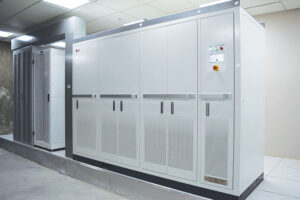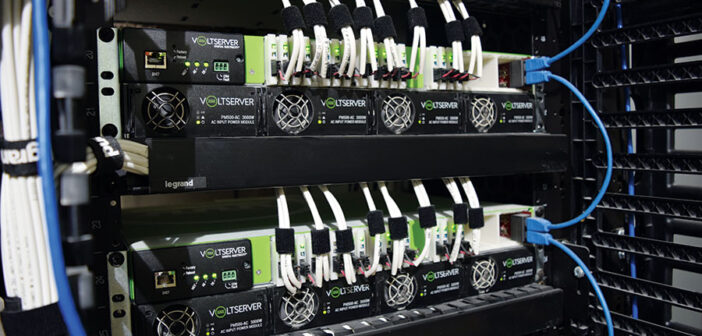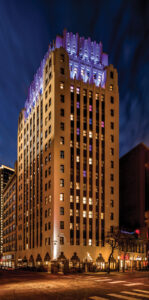On the outside, the Sinclair Hotel in Fort Worth, TX, might just look like any other historic building-turned-hotel. On the inside, however, it is a real game-changer for the industry. As the world’s first low-voltage hotel, it has revolutionized the way power is provided in the built environment.
Farukh Aslam, president/CEO, Sinclair Holdings LLC, is the owner of the Autograph Collection hotel and the mastermind behind the whole low-voltage process. From engineering building code changes to being a catalyst in the creation of a new way to provide backup building electricity, he has developed the hotel of the future, and is taking the technology to new projects.
“We’re changing how we think of electricity as AC power, and replacing that with DC power from ethernet cables,” he said of the process called digital electricity via Power over Ethernet (PoE).
Using DC power is not a new concept—“you’ve had this technology for 20 years around you in your desk phone and your security cameras in your office,” Aslam noted as examples—but in order to provide DC power, an inverter is used to convert AC power.
“LED lighting technology is 100% low-voltage DC, but our infrastructure is AC,” he pointed out. “So, instead of trying to change the infrastructure, the lighting manufacturer started embedding a driver that takes the incoming high-voltage AC power and changes it into DC power using an inverter. Whenever you invert from AC to DC, there is an inefficiency anywhere from 15-18%.”
Because energy cannot be created, but rather transformed from one form to another, that inefficiency comes out as heat energy. That, naturally, leads to a higher cooling cost.
He added, “If a light has been on for an hour or more and you grab it, it’s going to be too hot to touch. At Sinclair, the lights can be running for 10 days nonstop, and if you grab it, it doesn’t even have a human body warmth in it; it’s really as cold as your room temperature. So, imagine 7,000 to 8,000 lights at Sinclair not generating heat.”
The switch to PoE has saved the hotel, which was originally the Dulaney Building when it opened in 1930, a lot of money in electricity costs.
“When I bought the building in 2013, it was an office building,” said Aslam. “It operated from Monday through Friday, and four hours on some Saturdays. It had a 200-ton chiller which came on at 7:00 a.m. and was turned off at 6:00 p.m. We then went to a 300-ton chiller for the hotel. Our electric bill has gone down from about $11,000 a month to $7,000, and now we are open 24/7.”
Aslam also was instrumental in modernizing the electrical backup systems for hotels and other buildings by exchanging the large diesel-powered generator the Sinclair originally had for one that runs on lithium battery power.
“Nobody had made a UPS backup system with lithium batteries that was bigger than five kWh, and we needed something like 250 kWh,” he said. So, he traveled to South Korea to visit the LG headquarters, where he learned about the company’s battery energy storage system (BESS). As an engineer himself, Aslam was able change some things to get the battery backup UL 294 (emergency use) certified and put the system in the hotel.
“You would think that it would fill up like a whole room in the basement,” he said. “Not at all. One server rack is enough to back up the Sinclar. The footprint is much smaller than a diesel generator and it is much more reliable.”

The battery energy storage system (BESS) allowed the Sinclair Hotel to dispose of its old diesel generator.
Purchasing Management International (PMI) was the purchasing company for the Sinclair Hotel project. “From an FF&E perspective, you don’t often hear of a groundbreaking thing,” said Carl Long, SVP, PMI. “I buy couches and drapery and carpeting and light fixtures. But Farukh said he wanted to do something where he was able to save a lot of money on the operation of a hotel and have a better idea of how to maintain it, and it turned out that what he wanted to do didn’t exist. So, we went out to bid on the furniture like we normally do. We went to the vendors and told them as part of the specs, the requirement was that it had to be powered by low voltage.”
That was a problem, he said, because it was new technology to the vendors, who had to then invent low-voltage products. “It took escalation within each of those organizations to the ownership of those companies, telling them that this is something the owner of the hotel is really invested in,” said Long.
When the Sinclair Hotel was finished, Aslam and his team realized that they could do the same project with one-third less hardware. “That means 1/3 less labor so as construction costs are increasing, we are innovating to do it for a third cheaper,” he said.
To develop new hotels with the same low-voltage technology as the Sinclair, he has created a consulting arm, now called Sinclair Digital Services Inc. This has led to the company working on two hotel projects: The Hotel Marcel in New Haven, CT, and the Magnolia Hotel in Dallas.
“The Hotel Marcel, which should open in the second quarter, is the first hotel in North America, possibly Europe and America, that is net-zero,” he said. “It’s a historic building outside of the Yale University campus that will be a 164-room, Hilton-flagged, full-service hotel. It will generate all its power from a solar array on the roof of the parking area, and will use the same battery technology as the Sinclair Hotel for energy storage for after-hours and nighttime.”
The Magnolia Hotel, he said, was originally built in 1920 as an office building that was converted to a hotel in 2000. Sinclair Digital Services is working on the design of the property




